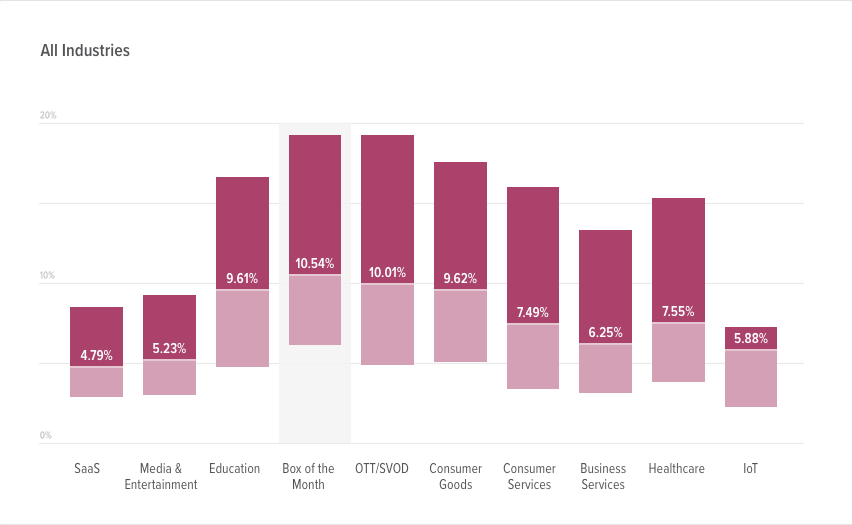Customer retention is essential in the world of SaaS. While it’s inevitable some customers will call it a day and unsubscribe, you still want to keep your churn rate super low.
It’s a matter of saving revenue. If your churn is high, then it’s bad news.
So, it’s a very important issue to get right. And here to help you with it is… us! Below, we explain the steps you need to take to stop churners from churning. First off, the basics.👇
What is churn rate?
It’s the amount of customers who stop subscribing to your product during a set time period. Basically, any user who cancels their subscription or doesn’t renew.
It’s an unbelievably important metric in the industry. If your users are paying a subscription fee (say, once a month), but start abandoning ship, then it should set alarm bells ringing.
Why? Because if you have a high churn rate you’ll start to lose revenue. And that means something isn’t right with your business model.
So, you’ll need to identify what the problem is. And then make some relevant changes to make your product better than ever.
But that doesn’t stop some SaaS businesses from starting to worry when churn rates go up.
Is it time to panic?
No, of course not. Because churn rate in SaaS is unavoidable. Everyone has it.
You just need to keep in mind your customer acquisition cost (CAC) to make sure you’re making your money back over time.
Rather than getting loads of new users at a high CAC, only for them to leg it early on in their subscription. 🏃♀️
What you need to aim for is a healthy churn rate. We cover that side in more detail further below. But before then, you need to know a thing or two about calculations.
How to calculate churn rate in SaaS
Right, you need to do this so you know how many customers are unsubscribing from your product. There are two ways to work it out:
- Customer churn: This measures the customer cancellation rate to your subscription service (most SaaS companies use this model). Your focus is to maximize new customers, while minimizing those who unsubscribe.
- Monthly recurring revenue (MRR) churn: The monthly loss of SaaS revenue. It’s better to define this amount as a percentage so you can keep track of losses/gains.
Okay, so you’ve decided on the approach you want to take? Groovy. Here’s the mathematical bit. The churn rate formula you’ll need to work out the total.

Remember, when you’re calculating you shouldn’t mix up billing periods. As in, don’t include annual subscriptions with monthly subscriptions.
After that, it’s time to calculate. Then you’re in the know. The question is, which metric is best? Well, it’s a good idea to keep track of both. Why?
- Customer churn covers your retention.
- Revenue churn covers your revenue generation.
Simply put, the metrics take a look at your business’ health. And understanding both provides you with important insights into your retention and upselling skill set.
The different types of churn rate
Not all churning is the same—there are four types to keep in mind. These are:
- Proactive churn: When customers close their subscriptions on purpose. In other words, the worst type of churn rate—the one you want to avoid most of all.
- Reactive churn: Where a customer doesn’t update their payment details, leading to account cancellation.
- Happy churn: You can be a bit more cheerful with this one. 😀 It’s where a customer ends their subscription because they’ve had full use from your software (e.g. they’ve ended a project and don’t need it anymore). This means they leave you on an upbeat note, with the possibility of returning another time.
- Fake churn: Some SaaS businesses have a 30 day money-back guarantee. You may want to measure this away from your other churn rates to understand why a subscriber leaves.
Whenever you spot your churn rate going up, do a check to see what’s responsible.
For your software, you’ll likely have cancellation options. Either to cancel on the spot, or at the end of a billing cycle.
It’s up to you how you recognize churn rate, but start by identifying any issues from the end of a paying period.
From there, you’re preparing yourself for potential risk customers—any users who show signs of calling it a day.
What’s a healthy churn rate?
The average churn rate for SaaS is a 5-7% benchmark. That’s what you should aim for.
In an ideal world, you wouldn’t have any customers leaving. But that’s not going to happen. So, you need to prepare for churn and decide what’s a “good” amount for your business.
That depends on what sector you’re in, as some have higher churn than others. But generally, a great churn rate is 3% or less. If you can reach lofty heights like that, you’re doing very well. But anything higher and you should look to address the issue.
Luckily, there are techniques around to help you out.
How to lower your churn rate
This is where you can go off and investigate your product. Get a monocle on and dive into your data. Dig around and see what you can find. 🧐
But there are some basic steps to take that may help you get back on track. These are:
- Analyze why your churn is happening. Take the appropriate steps to fix your issues.
- Ask your customers—drop them an email asking why they’re unsubscribing. Keep things friendly, of course, and act on the constructive feedback they provide.
- Make sure your onboarding process sets users off on the right track.
- Offer incentives to stay on, such as flash sales, a free month, access to all of your software’s features etc.
- Look to improve your customer support service, so your users have everything they need to stay on.
Remember, you’re building customer relationships across all of your product. So be on the lookout for nifty ways to make your UI more accessible. Or intuitive. Or fun!
All the same, part of being in SaaS is about accepting some customers will churn. But if you can limit this as much as possible, your customer success retention will continue on.
A bit about B2C churn rates

Okay, so most of SaaS is B2B. But there are B2C companies as well, which see a difference in the customers they retain.
B2C companies can also see a slightly higher churn rate than in B2B. That’s largely because of the different markets the two operate in.
In B2C, businesses are delivering a product to individuals. That means a much bigger market with a lot more competition.
Below you can see B2C calculations, just so you’re in the know. This is different to the B2B formulas, so worth noting down. Here they all are in a handy table for you. 👇

To lower churn rates in B2C, it’s a good idea to focus on building connections with individuals.
An example of this is good old Netflix—the equivalent of a digital friend that doesn’t talk and just plays movies.
The company makes sure its content is great, so users stay on. The trick for other B2Cs is to do the same.
In a competitive market, you must look for ways to offer a unique product with real value. This’ll help to keep your customers subscribing.
Looking for more churn rate help?
Well, there’s our FoSaaS membership plans. Sign up for all the tools you need with unlimited materials, unparalleled coverage, and personal growth tactics.
We have templates for a churn rate cheat sheet and how to lower your churn. Well worth a look to master your customer retention strategies.

